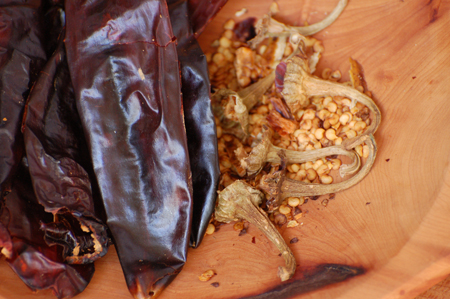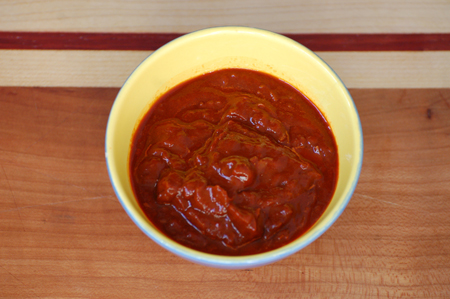
It all started when I agreed to chaperon a group of 18 Flinn Scholars from the UA Honors College and ASU to Mexico for the weekend. Our destination: El Centro de Estudios de Desierto y Oceanos – a biological institute in Las Conchas, just southeast of the fishing village of Puerto Peñasco. I was told by the students who had attended this community-building weekend in the past that I would love the food. And they were right.
A few words about the Flinn Scholars – these students are amazing. They all have double and triple majors, and most have several minors. They speak multiple languages, study hard, travel often and even know how to have fun. The Flinn Foundation in Phoenix, Arizona, provides the scholarships for them to attend one of three Arizona Universities. Most Flinns choose the UA Honors College or Barrett at ASU. While these two schools are major rivals in almost every arena, the relationship the students have as Flinn Scholars bridges all differences, squelches rivalry and the result is a true community of scholars. In the end, the Flinn Foundation gives so much more than scholarship funding. They teach these young women and men how to communicate, how to think critically and – best of all – the importance of community.
Okay – back to FlinnFest 2011. I was in the lead van which was abuzz with friends reconnecting, sharing stories of prior gatherings; the other two vans reported napping and studying. The roadside wildflowers were sparse due to the infrequent winter rains this year in the desert, and we saw only a few flying critters of any note – the occasional buzzard and a single crested caracara just as we neared the border. We found our way to Las Conchas without incident just as the sun was setting. Dinner was waiting for us.
Olivia and her assistant Norma made us our two shared meals while we were there – one dinner and one lunch. Our dinner that evening consisted of a gordita, two carne asada tacos and a cheese quesadilla – served with salsas Olivia made for that evening. For our beverage, Olivia made a big batch of delicious jamaica – a traditional Mexican beverage made from hibiscus flowers, tasting much like cold Red Zinger tea. Lunch the next day was barbacoa with beans and red rice, seen here served by Olivia.
I was familiar with most of this food and drink – but not the gordita. I was pretty sure I had heard of them from a Taco Bell commercial, but that (of course) made me assume they weren’t authentic – a marketing ploy to make Americans think it is traditional ethnic food. Remember when Madison Avenue came up with Frusen Glâdjé® to sound like a Swedish ice cream?
So, while Olivia prepared the barbacoa for lunch, I (with my pathetic, almost non-existent Spanish and with the help of CEDO staff member Maria Tereza) grilled her about the recipe for the gorditas. The base of the gordita is a 4-inch disk similar to a corn tortilla but thicker – about 1/8-inch thick – these are called sopes (pronounced SO-pace). She told me I could buy them in the market, which I did, but that they were easy to make.

The meat that topped the sopes was carne chile colorado, or beef with red chile sauce. That is topped with shredded cabbage or lettuce, salsa fresca, avocados and queso fresco. A final squeeze of fresh Mexican lime juice brings out all the flavors. Simple. A perfect starter or even main course if you eat two or three. I returned to the US a happy cook with a new recipe.
 But wait! How do I make the carne chile colorado? I turned to two good friends – Pamela and Nicky (both good cooks) and got a recipe from each for the chile colorado. While their recipes are similar, they are just different enough that I chose the middle ground and used a bit from each. The key for both of them is to use the right cut of meat – a chuck roast. Second in importance is the slow cooking: use the crock pot. Ugh. How did I live through the 70s and beyond without ever having a crock pot?
But wait! How do I make the carne chile colorado? I turned to two good friends – Pamela and Nicky (both good cooks) and got a recipe from each for the chile colorado. While their recipes are similar, they are just different enough that I chose the middle ground and used a bit from each. The key for both of them is to use the right cut of meat – a chuck roast. Second in importance is the slow cooking: use the crock pot. Ugh. How did I live through the 70s and beyond without ever having a crock pot?
A call to our neighbor, Connie. “May I borrow your crock pot for the day?”
I followed my combination of Pamela’s and Nicky’s instructions and waited as the beef simmered in the pot. It could be done overnight but I thought the aromas would keep me awake all night so I opted for daytime cooking. After 9-10 hours it was done and pulled apart like butter.
The main difference between the recipes they gave me was the actual chile colorado. Pamela likes hers hot and mixes half hot New Mexico chiles with half mild New Mexico chiles. Nicky uses all mild. I opted for a 70/30 split. Just the right amount of heat!
Finally, as I mentioned, I did purchase the sopes at the market in Mexico. I will not be doing that again. Olivia’s were crispy and airy – like a perfect pillow for the toppings. Nicky and Pamela both tell me that they will teach me how to make them. In the interim, though, I suggest that you check out Mexican Goods; this recipe seems to be exactly what both women have described to me. Maybe you can try them and tell me how they came out?
So, in the end, it took a village of friends to teach me how to make gorditas… Olivia, Norma, Pamela, Nicky and Connie. And, of course, I would never have had this opportunity without my new Flinn friends!
Buen provecho!
– David
Developed and maintained by Inspiratech LLC.
Design by Themeshift.
Ann
April 5, 2011 at 6:19 pmYum! I think I will have to try this one. I, too, do not have a crock pot, but I noticed a whole stock of them at the Goodwill. They didn't look used, either. I cheap and green way of shopping!
Ann
Cocoa & Lavender
April 5, 2011 at 7:28 pmGreat idea for finding a crock pot, Ann! Thanks for the tip.
David
mariatereza
April 9, 2011 at 12:48 amDelicious! I'll be seeing Olivia again tomorrow and will make sure to show her. 😀
Maria Tereza
Cocoa & Lavender
April 9, 2011 at 1:27 amThanks, Maria Tereza! Hope she is proud of her student!
Susan
April 14, 2011 at 3:20 pmI will be going to southern California soon to visit my mother, also a reader of Cocoa and Lavender, and we are planning to make your gorditas. My mother is a terrific cook of Mexican cuisine, probably because our family spent many summers driving to Puebla and Mexico City from California (to visit my aunt and uncle and cousins who lived in Mexico and, in fact, my aunt and uncle have just returned to live). It was a long drive punctuated by many stops for Mexican food (although I distinctly remember refusing to eat anything other than a turkey sandwich–white meat only–on toasted bread, white only, and I probably wanted the crusted cut off!) and, once there, many more Mexican meals. I remember my mother and my aunt spending a lot of time in the kitchen with the cooks, hovering over pots and collecting details about how to cook a particular meal. My mother has never made gorditas although she knew of them–as appetizers! We are both very excited! Excellent article and photos!
Gracias,
Susan
Cocoa & Lavender
April 14, 2011 at 3:53 pmSusan,
Gorditas are, indeed, appetizers although, if (like us) you eat three, they can easily become a main course! I look forward to hearing about your making of them with Marilyn, and only wish I could be there with you! I am so glad you enjoyed the article and photos.
Abrazos, David
carne asada restaurant
February 1, 2014 at 3:48 amThis was a great article that really was really helpful to me and I really can’t wait to learn more from your valuable experience. This was really very interesting to me
Cocoa & Lavender
February 1, 2014 at 4:39 amThanks – glad you enjoyed it!